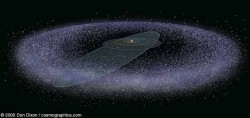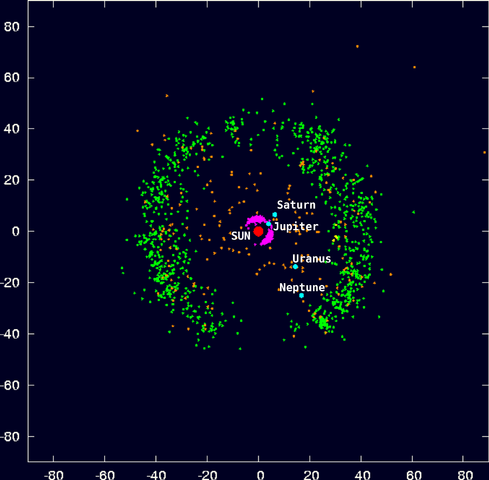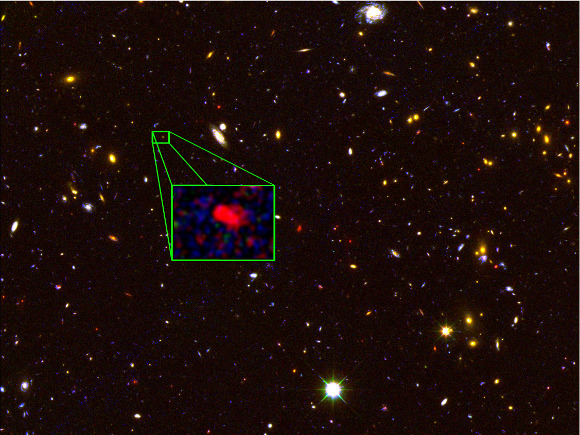The Kuiper belt — the region beyond the orbit of Neptune inhabited by a number of small bodies of rock and ice — hides many clues about the early days of the Solar System. According to the standard picture of Solar System formation, many planetesimals were born in the chaotic region where the giant planets now reside. Some were thrown out beyond the orbit of Neptune, while others stayed put in the form of Trojan asteroids (which orbit in the same trajectory as Jupiter and other planets). This is called the Nice model.
However, not all Kuiper belt objects (KBOs) play nicely with the Nice model.
(I should point out that the model is named named for the city in France and therefore pronounced “neese”.) A new study of large scale surveys of KBOs revealed that those with nearly circular orbits lying roughly in the same plane as the orbits of the major planets don’t fit the Nice model, while those with irregular orbits do. It’s a puzzling anomaly, one with no immediate resolution, but it hints that we need to refine our Solar System formation models.
This new study is described in a recently released paper by Wesley Fraser, Mike Brown, Alessandro Morbidelli, Alex Parker, and Konstantin Baygin (to be published in the Astrophysical Journal, available online). These researchers combined data from seven different surveys of KBOs to determine roughly how many of each size of object are in the Solar System, which in turn is a good gauge of the environment in which they formed.
The difference between this and previous studies is the use of absolute magnitudes — a measure of how bright an object really is — as opposed to their apparent magnitudes, which are simply how bright an object appears. The two types of magnitude are related by the distance an object is from Earth, so the observational challenge comes down to accurate distance measurements. Absolute magnitude is also related to the size of an KBO and its albedo (how much light it reflects), both important physical quantities for understanding formation and composition.
Finding the absolute magnitudes for KBOs is more challenging than apparent magnitudes for obvious reasons: these are small objects, often not resolved as anything other than points of light in a telescope. That means requires measuring the distance to each KBO as accurately as possible. As the authors of the study point out, even small errors in distance measurements can have a large effect on the estimated absolute magnitude.

In terms of orbits, KBOs fall into two categories: “hot” and “cold”, confusing terms having nothing to do with temperature. The “cold” KBOs are those with nearly circular orbits (low eccentricity, in mathematical terms) and low inclinations, meaning their trajectories lie nearly in the ecliptic plane, where the eight canonical planets also orbit. In other words, these objects have nearly planet-like orbits. The “hot” KBOs have elongated orbits and higher inclinations, behavior more akin to comets.
The authors of the new study found that the hot KBOs have the same distribution of sizes as the Trojan asteroids, meaning there are the same relative number of small, medium, and large KBOs and similarly sized Trojans. That hints at a probable common origin in the early days of the Solar System. This is in line with the Nice model, which predicts that, as they migrated into their current orbits, the giant planets kicked many planetesimals out beyond Neptune.
However, the cold KBOs don’t match that pattern at all: there are fewer large KBOs relative to smaller objects. To make matters more strange, both hot and cold seem to follow the same pattern for the smaller bodies, only deviating at larger masses, which is at odds with expectations if the cold KBOs formed where they orbit today.
To put it another way, the Nice model as it stands could explain the hot KBOs and Trojans, but not the cold. That doesn’t mean all is lost, of course. The Nice model seems to do very well except for a few nagging problems, so it’s unlikely that it’s completely wrong. As we’ve learned from studying exoplanet systems, planet formation models are a work in progress — and astronomers are an ingenious lot.




